The train HVAC Market is estimated to be valued at US$ 15.09 Bn in 2025 and is expected to reach US$ 20.00 Bn by 2032, growing at a compound annual growth rate (CAGR) of 4.1% from 2025 to 2032.
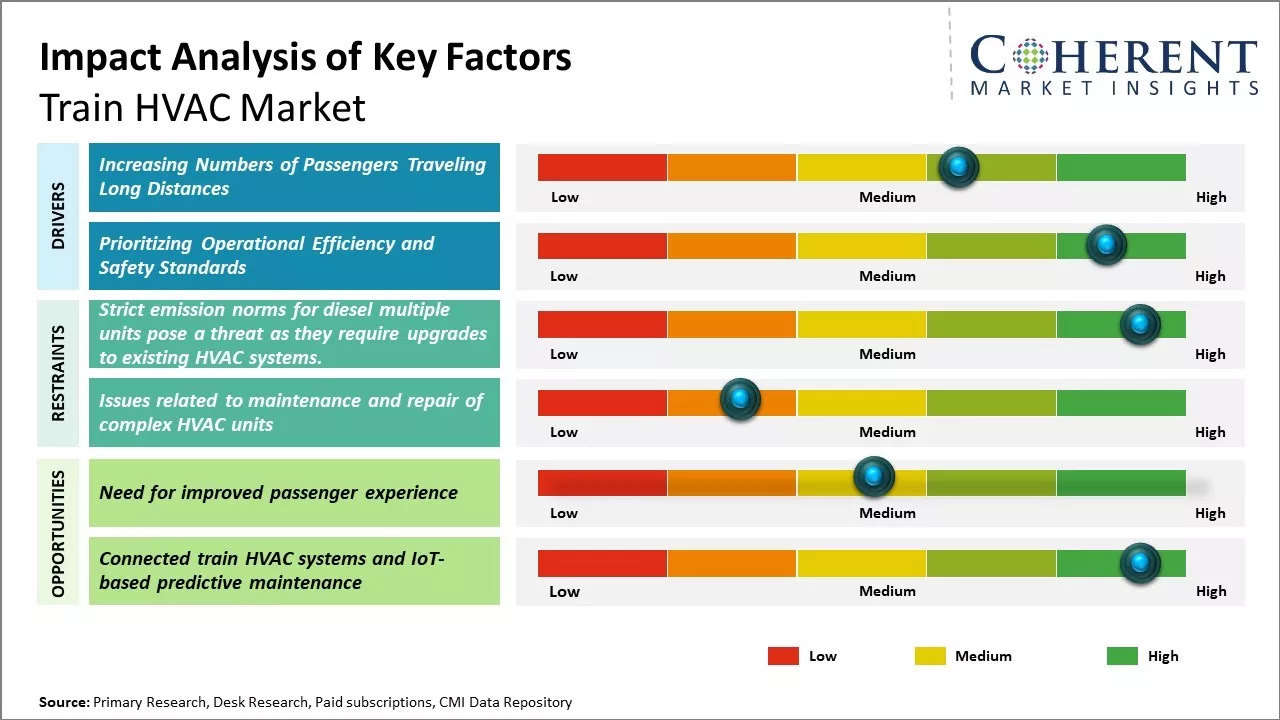
Discover market dynamics shaping the industry: Download Free Sample
The increasing demand for energy-efficient and eco-friendly Heat Ventilation and Air Conditioning (HVACsystems for trains is driving the market growth. Modern train HVAC systems allow adjustable temperature control for passengers and use refrigerants that are eco-friendly and cause lesser harm to the ozone layer. Moreover, growing focus on passenger comfort and rising spending on railway infrastructure development projects across various countries are also fueling the adoption of advanced HVAC systems in trains. However, high initial costs associated with the installation and maintenance of train HVAC systems can hamper the market growth.
Increasing Numbers of Passengers Traveling Long Distances
With more efficient and hassle-free transportation becoming a necessity in today's fast-paced world, the demand for high-speed train travel has surged exponentially. As city dwellers and busy professionals seek to reduce travel time and optimize productivity, trains have emerged as a preferred mode of transportation for long-haul routes. This has significantly increased passenger loads on major rail corridors within and between countries. With millions of people commuting long distances on a regular basis, maintaining thermal comfort during the entirety of their journey has become a priority. The conventional practice of simply relying on ambient airflow is proving inadequate, considering trains today carry passengers for over hundreds of miles at high speeds. This has propelled the need for sophisticated HVAC systems that can effectively manage airflow, humidity, and temperature inside rail coaches irrespective of external weather conditions or number of occupants. Train operators are actively integrating advanced climate control solutions to enhance the travel experience and satisfy more discerning passenger expectations.
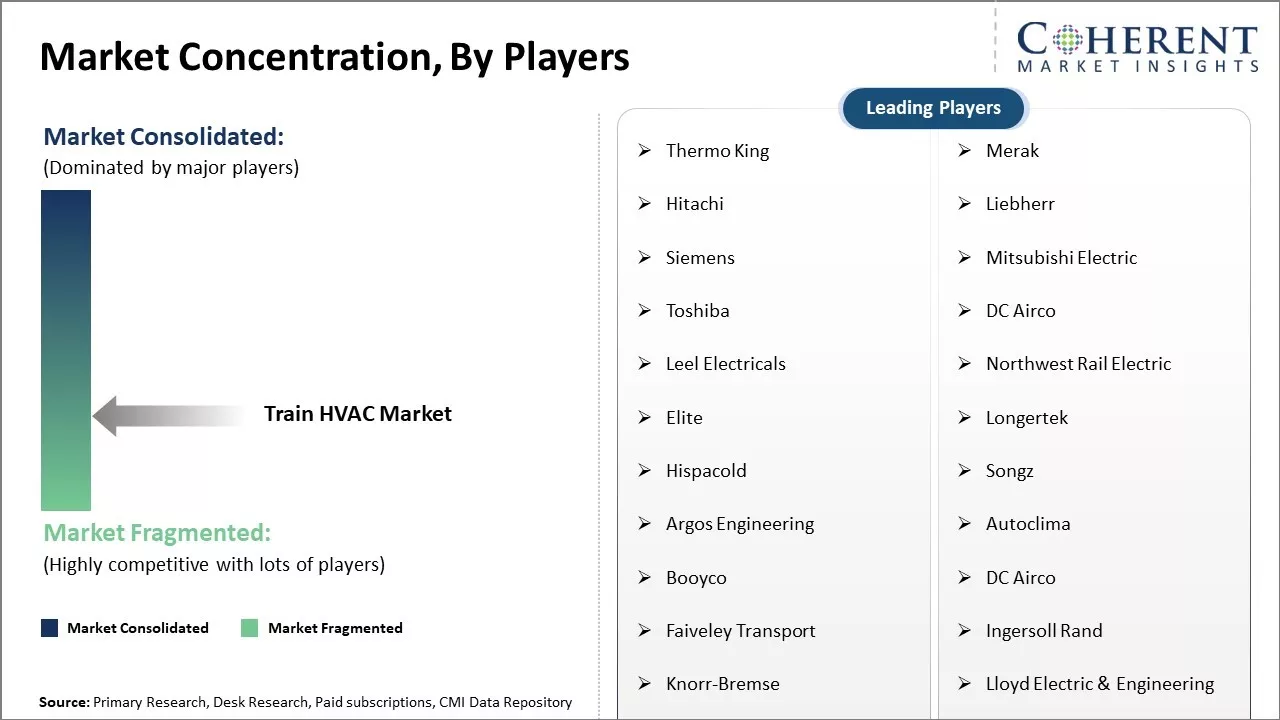
Get actionable strategies to beat competition: Download Free Sample
Prioritizing Operational Efficiency and Safety StandardsMounting concerns around fuel efficiency, carbon emissions, and overhead operating costs have also compelled train operators to upgrade their fleets with modern HVAC units. Older systems lacking precise controls hamper efforts to optimize resource usage and reduce energy consumption during train runs. Additionally, growing safety standards require maintaining thermal neutrality within narrow limits aboard trains. This helps ensure passenger well-being is not compromised even during extreme weathers or unforeseen technical difficulties mid-journey. Regulatory nudges towards certifying rolling stock fit for all weather operations have become an industry imperative today. Leading manufacturers are thus innovating to develop sophisticated HVAC solutions integrating technologies like sensor-based auto-climate, regenerative braking and waste heat recovery. When combined with centralized monitoring and fleet management solutions, they enable achieving peak performance efficiency. Such newly integrated systems assure uninterrupted operations despite dynamic service requirements. This doubles up as a long-term value proposition for carriers prioritizing sustainability.
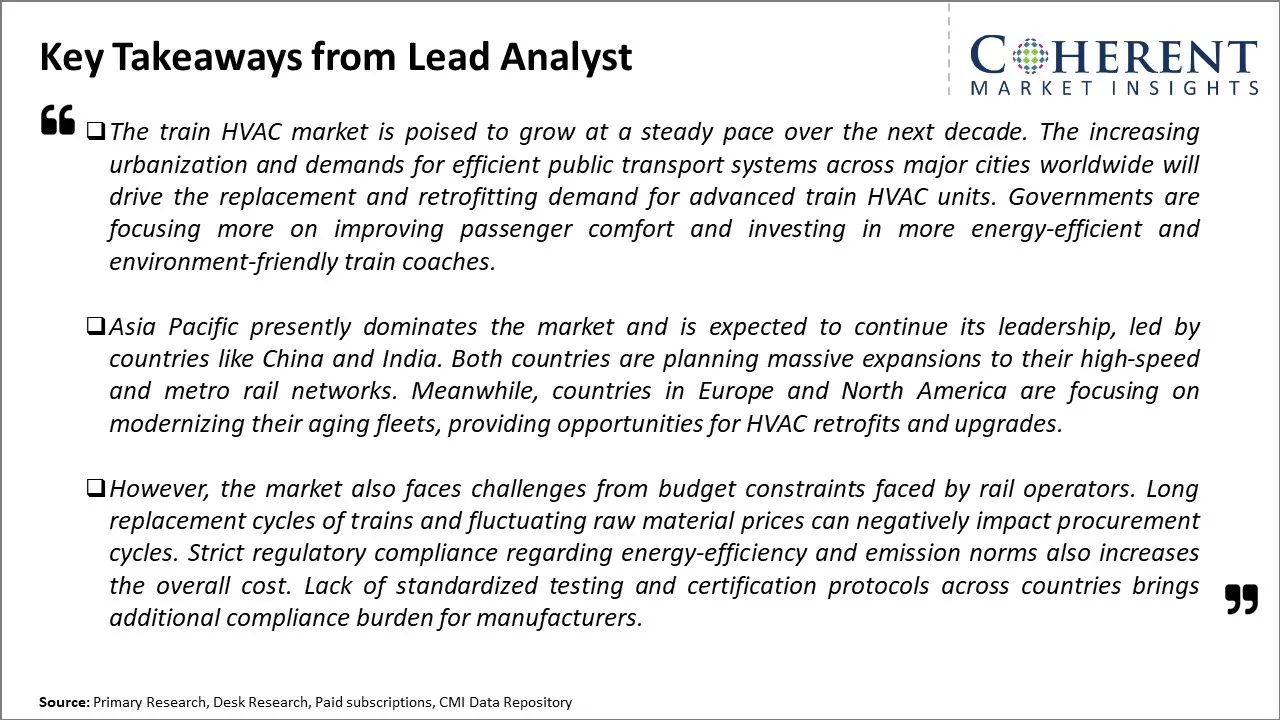
To learn more about this report, Download Free Sample
Market Challenges: Strict emission norms for diesel multiple units pose a threat as they require upgrades to existing HVAC systemsStrict emission norms for diesel multiple units pose a threat as they require upgrades to existing HVAC systems. Space constraints within trains restrict addition of more efficient systems. Maintaining airflow and thermal comfort across all passenger cabins with varying load and ambient conditions is difficult. High initial costs and long replacement cycles of train HVAC systems lower adoption of new technologies. Operators also have to ensure resilient systems for diverse climates across routes.
Market Opportunities: Need for improved passenger experience
More trains are being inducted globally to support rapid urbanization and expand rail network. This stimulates demand for advanced HVAC solutions. Systems with higher energy efficiency and lighter weight can help optimize operating costs. The need for improved passenger experience will drive innovations around thermal comfort, indoor air quality, and smart controls.
Insights, By Train Type- Growing Travel Demand Fuels Passenger Train Dominance
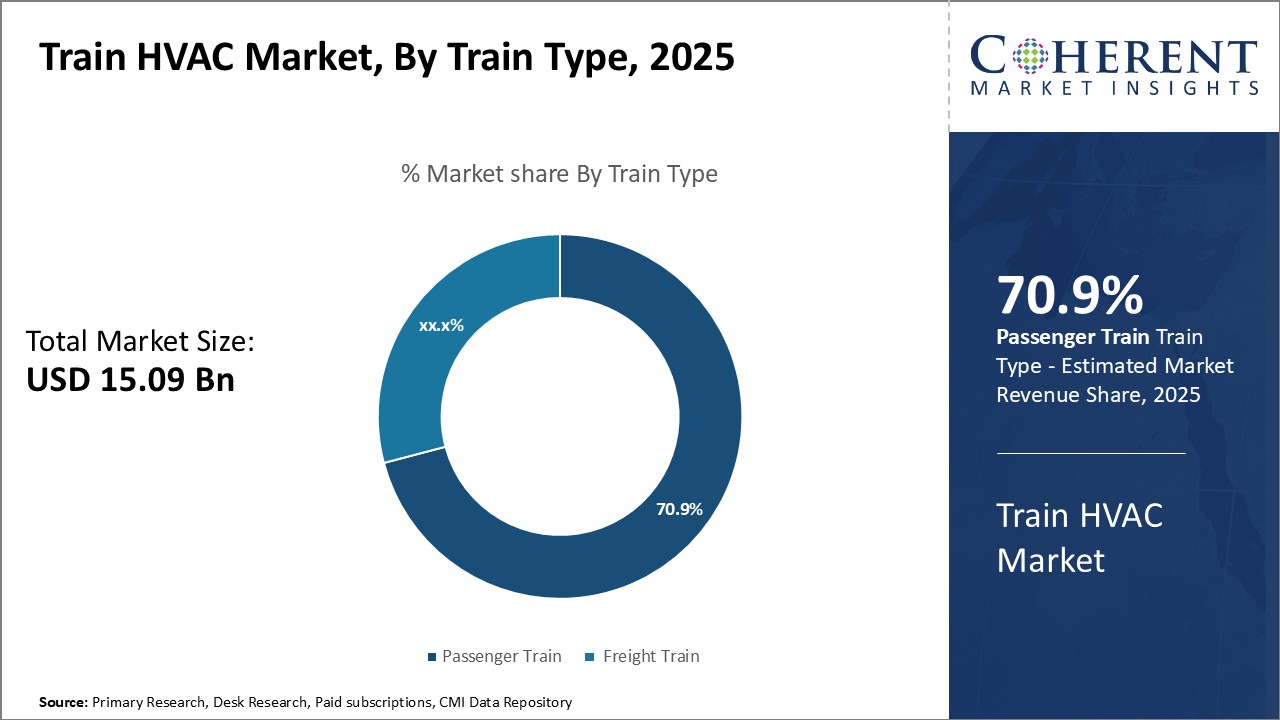
Discover high revenue pocket segments and roadmap to it: Download Free Sample
In terms of train type, passenger train contributes the highest share of the market owing 70.9% in 2025 to rising travel demand globally. As populations increase and urbanization spreads, the need for transportation within and between cities has grown exponentially. While aircraft and private vehicles have offered options, their infrastructure requirements and costs have limited scalability. By contrast, passenger trains leverage existing railway lines to move far greater volumes of people in a sustainable manner.
A key driver is the growth of commuters. Expanding job markets have pulled workers further from their homes, necessitating daily long-distance trips that planes cannot support and cars get stuck in traffic for. Trains provide a viable alternative that lets commuters productively use travel time. Younger generations too have embraced train travel for its flexibility and environmental friendliness relative to other modes. This is spurring passenger numbers not just for work but also leisure travel like vacations and visiting friends/family.
Governments are also focusing on passenger rail to curb air pollution and road congestion in cities. Investments are flowing into high-speed rail networks as well as upgrading conventional lines. This is improving journey times, frequencies, safety and passenger experience. The integration of WiFi and entertainment systems further enhances train travel, making it preferable to less convenient options. Rising income levels allow more discretionary spending on such transport. Overall, the confluence of these social, economic and environmental factors means passenger trains will continue dominating the train HVAC market segment.
Insights, By Systems- Vapour Cycle Systems Lead in HVAC Technology
Within train HVAC systems, vapour cycle systems have secured the largest share owing 69.8% in 2025 to their superior temperature control capabilities. Passengers expect consistent comfortable conditioning given the enclosed train compartment environment and varying outdoor climates en route. While early air cycle systems provided air ventilation, they could not finely regulate air parameters like temperature and humidity ratios across different weather. Vapour cycle or vapor-compression refrigeration emerged as a more advanced solution.
Using a simple yet highly effective cycle, vapour cycle systems exploit the thermodynamic properties of a working fluid like ammonia or chlorofluorocarbons. During phase changes from gas to liquid and back, these fluids efficiently absorb and release heat for cooling and heating purposes. Temperature sensors coordinate compressor, evaporator, condenser and expansion devices to achieve very precise indoor climate setup independent of outdoor ambient conditions. The compact packaged design also occupies minimal space on board.
Maintenance of vapour cycle systems requires less manual effort than air cycle counterparts thanks to automated digital controls. Their hermetic sealing further enhances reliability by containing refrigerants. With continued research, today's models have increased energy efficiency to reduce running costs for operators while maintaining strong performance. Overall superior thermal management and lower lifetime expenditures make vapour cycle systems the technology of choice for train HVAC applications.
Insights, By Refrigerants- Conventional Refrigerants Remain Standard
Among refrigerants used in train HVAC systems, conventional refrigerants currently hold the leading market share owing 72.1% in 2025 . While environmental issues raise questions around these chemicals, their widespread availability, proven performance, and lower costs have sustained their popularity to date.
Hydrochlorofluorocarbons (HCFCs) such as R-22 and HFCs (hydrofluorocarbons) including R-134a represent conventional options are commonly employed in vapour cycle units. Their zero flame-propagation characteristics enhance safety on board trains transporting large passenger loads. Thermal properties such as high heat absorption capacities precisely match the thermal demands of HVAC equipment in rail carriages.
Component manufacturers have built up extensive experience and supply chain linkages oriented around conventional refrigerants. Refrigerant recovery, recycling and reclaim initiatives also help minimize discharge risks. Given their scalable production and integration into existing system designs, retrofitting fleets to alternative refrigerants would require significant cost and time.
While natural alternatives such as CO2, ammonia, and hydrocarbons eliminate ozone depletion and global warming aspects, limitations around flammability, operating pressures, and energy efficiency have slowed their adoption. More data on performance reliability under heavy usage schedules is likewise needed to assure operators. Overall the comfort of proven technology and economics perpetuate conventional refrigerant dominance for the time being.
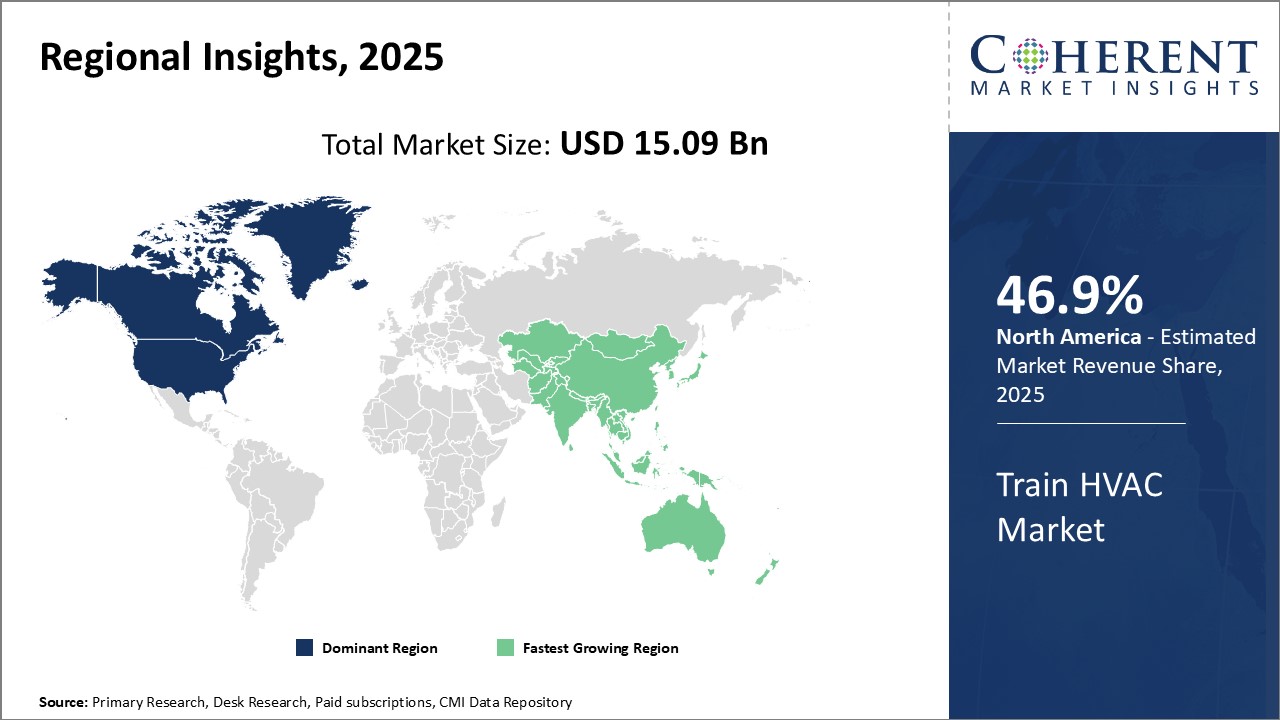
Need a Different Region or Segment? Download Free Sample
North America has established itself as the dominant region in the global train HVAC market owing 46.9%in 2025. This can be attributed to the presence of leading HVAC system manufacturers like Siemens, Knorr-Bremse, and Wabtec in the region who have made huge investments in R&D and product development. For decades, these companies have consistently innovated and launched cutting-edge HVAC units tailored for trains plying across different terrains in the U.S and Canada. As a result, they have captured a massive share of the replacements and refurbishment market in this region.
Furthermore, the U.S and Canada have an extensive rail network with high ridership, necessitating efficient HVAC equipment onboard trains. Stricter emission norms have also propelled rail operators here to upgrade to energy-efficient HVAC systems. The large domestic market and proximity to global leaders have made North America a manufacturing and export hub for train HVAC components. Major manufacturers have set up production plants catering to both regional needs as well as international export orders.
Coming to pricing, the trained workforce, manufacturing expertise, and economies of scale help companies offer competitive rates to North American rail operators compared to imported equipment. This has reinforced their dominance in this important region over the years.
Among new and emerging markets, Asia Pacific is showing promising growth in the train HVAC sector. Factors such as expanding commuter rail infrastructure, increasing passenger traffic and investments in rail modernization are driving this growth. Countries like China, India, and Japan are actively procuring new trains and retrofitting existing fleets. Their focus on indigenization under the ‘Make in India’ and ‘Make in China’ initiatives is also spurring local HVAC manufacturers to ramp up production.
The region has emerged as an attractive outsourcing hub, with Original Equipment Manufacturers (OEMs) setting up manufacturing bases to cater to Asian and Middle Eastern markets. This is strengthening the supply chain and making HVAC solutions more affordable for rail operators here. As more Asian countries invest in rail, the demand for modern HVAC equipment onboard is expected to rise substantially in the coming years, cementing Asia Pacific's position as the fastest growing regional market.
Train HVAC Market Report Coverage
| Report Coverage | Details | ||
|---|---|---|---|
| Base Year: | 2024 | Market Size in 2025: | USD 15.09 Bn |
| Historical Data for: | 2020 To 2024 | Forecast Period: | 2025 To 2032 |
| Forecast Period 2025 to 2032 CAGR: | 4.1% | 2032 Value Projection: | USD 20.00 Bn |
| Geographies covered: |
|
||
| Segments covered: |
|
||
| Companies covered: |
Thermo King, Merak, Hitachi, Liebherr, Siemens, Mitsubishi Electric, Toshiba, DC Airco, Leel Electricals, Northwest Rail Electric, Elite, Longertek, Hispacold, Songz, Argos Engineering, Autoclima, Booyco, DC Airco, Faiveley Transport, Ingersoll Rand, Knorr-Bremse, Lloyd Electric & Engineering, Specialist Mechanical Engineers, and Trans Elektro |
||
| Growth Drivers: |
|
||
| Restraints & Challenges: |
|
||
Uncover macros and micros vetted on 75+ parameters: Get instant access to report
*Definition: The train HVAC market consists of companies that design, manufacture, and install the climate control systems used on trains. These systems are specially designed to maintain a comfortable temperature inside passenger coaches as trains travel at high speeds. They circulate fresh air, remove odors and humidify the air. They need to operate reliably in all weather conditions and terrain while consuming minimal electricity.
Share
Share
About Author
Ankur Rai is a Research Consultant with over 5 years of experience in handling consulting and syndicated reports across diverse sectors. He manages consulting and market research projects centered on go-to-market strategy, opportunity analysis, competitive landscape, and market size estimation and forecasting. He also advises clients on identifying and targeting absolute opportunities to penetrate untapped markets.
Missing comfort of reading report in your local language? Find your preferred language :
Transform your Strategy with Exclusive Trending Reports :
Frequently Asked Questions
Joining thousands of companies around the world committed to making the Excellent Business Solutions.
View All Our Clients